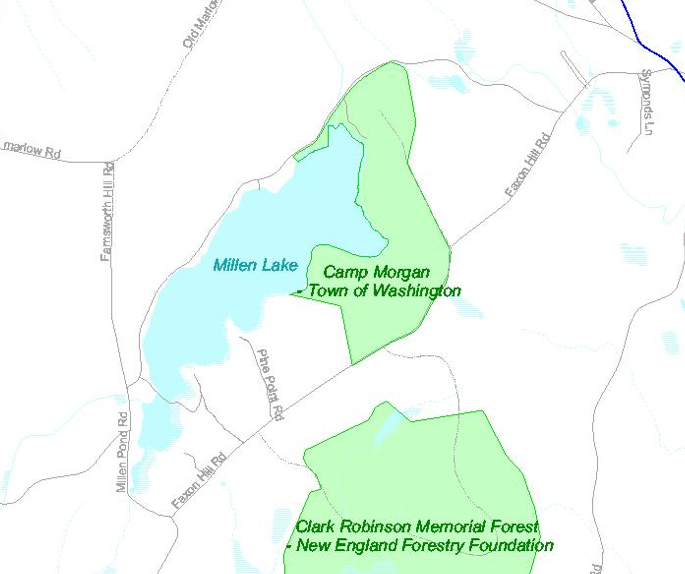|
Camp Morgan is close to the Clark Robinson
Memorial Forest that contains most of Oak Hill. The Camp Morgan
property has thousands of feet of unspoiled shoreline surrounding
the northern end of Millen Pond. The Town School, Public Beach,
Ballfield and Lodge building are all situated on Camp Morgan,
in a 26-acre section of the property just south of Millen
Pond Road. As these areas are not considered part of the Town
Forest lands, they will not be considered in the following
description of the Camp Morgan property. There are two areas
totaling 131 acres that are currently undeveloped and forested:
the 23-acre section just north of Millen Pond Road, and the
108 acres of unbroken forest south of the Town buildings and
recreational area.

A good variety of wildlife habitats can be found on Camp Morgan.
The section north of Millen Pond Road was heavily cut in large
patches, promoting raspberries and blackberries and fruiting
shrubs. This young, early successional habitat is very good
for a number of game and non-game species, including woodcock,
rabbits, and a whole host of songbirds. Poplar stands are
located just south of the Lodge building. Poplar stands are
very important for species such as ruffed grouse and deer,
and are getting harder to find in some parts of the state.
Other forested stands provide both hardwood and softwood cover
and foods. The nearby Pond is both an important water source
for wildlife and an aquatic habitat that supports fish-eating
birds such as loon and osprey.
There are five management units on the Camp Morgan Forest:
1) MU 1 is an exemplary stand of mature hemlock forest growing
along the shore of Millen Pond. Other tree species include
red maple, yellow birch and red spruce, ranging in size from
poles to large sawtimber. This MU is a very uncommon example
of an old growth hemlock forest, and should never be cut.
2) MU 2 is an exemplary stand of mature white ash, sugar maple,
red oak and beech, growing just south and uphill of MU1. A
small clump of towering white pines are also here, which will
be excellent nesting trees for bald eagles should their numbers
continue to increase. Containing some marvelous specimens
of very old and large hardwoods, and a diversity of herbaceous
plants that includes the round-leaved orchis, this MU is a
very uncommon example of a mature hardwood forest that will
only become more rare as time goes by. With the exception
of the western edge (which should be salvaged along with MU4),
the majority of this MU should never be cut.
3) MU 3 is a
mature stand of white pine, red spruce and red maple found
on the eastern end of the property. While there are many large
sawtimber-sized stems in the canopy of this stand, there are
also many hardwood poles that includes species such as sugar
maple and black cherry.
4) MU 4 consists of two mature stands
of white pine, with occasional mature white ash and red maple
mixed in. These stands are largely stagnating, with dense
hardwood regeneration waiting for an opportunity to reclaim
the canopy. Given the moist and fertile nature of these soils,
the presence of abundant white pine must be the result of
old-field succession, as hardwoods would normally comprise
the bulk of such forests.
5) MU 5 is a patchy stand of scattered
mature red maple, birch, sugar maple and beech, with poles
of the same species growing below.
|

